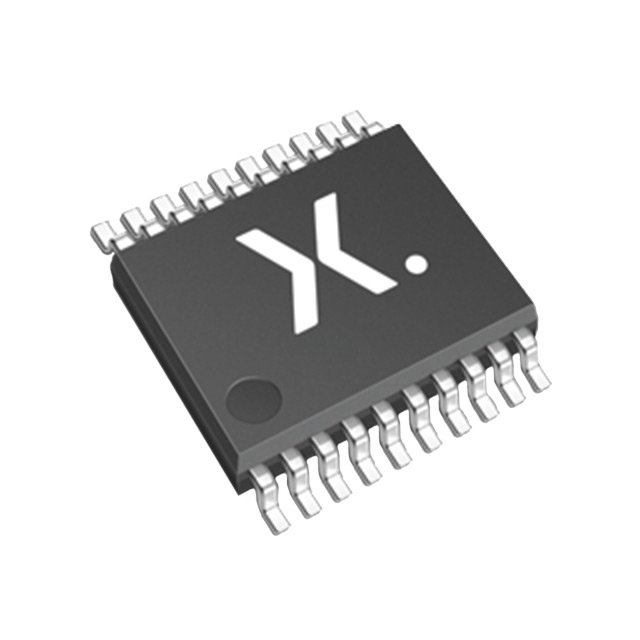Lihat spesifikasi untuk detail produk.

74HC240PW,112
Product Overview
- Category: Integrated Circuit
- Use: Logic Gate
- Characteristics: High-speed, CMOS technology
- Package: TSSOP (Thin Shrink Small Outline Package)
- Essence: Octal buffer/line driver with 3-state outputs
- Packaging/Quantity: Tape and Reel, 2500 units per reel
Specifications
- Supply Voltage Range: 2.0V to 6.0V
- Input Voltage Range: 0V to VCC
- Output Voltage Range: 0V to VCC
- Operating Temperature Range: -40°C to +125°C
- Input Capacitance: 3.5pF
- Output Capacitance: 6pF
- Propagation Delay Time: 9ns
- Maximum Quiescent Current: 4µA
Detailed Pin Configuration
The 74HC240PW,112 has a total of 20 pins, which are arranged as follows:
- GND (Ground)
- A1 (Input A1)
- A2 (Input A2)
- A3 (Input A3)
- A4 (Input A4)
- A5 (Input A5)
- A6 (Input A6)
- A7 (Input A7)
- A8 (Input A8)
- OE (Output Enable)
- Y1 (Output Y1)
- Y2 (Output Y2)
- Y3 (Output Y3)
- Y4 (Output Y4)
- Y5 (Output Y5)
- Y6 (Output Y6)
- Y7 (Output Y7)
- Y8 (Output Y8)
- VCC (Supply Voltage)
- GND (Ground)
Functional Features
- Octal buffer/line driver with 3-state outputs
- Non-inverting outputs
- High-speed CMOS technology
- Balanced propagation delays
- Wide operating voltage range
- Low power consumption
- ESD protection: HBM JESD22-A114E (2000V), MM JESD22-A115-A (200V)
Advantages and Disadvantages
Advantages: - High-speed operation - Wide operating voltage range - Low power consumption - ESD protection for enhanced reliability
Disadvantages: - Limited number of inputs and outputs (8 each) - Not suitable for applications requiring a large number of logic gates
Working Principles
The 74HC240PW,112 is an octal buffer/line driver that provides non-inverting outputs. It operates using high-speed CMOS technology, allowing for fast signal transmission. The device has 3-state outputs, which means they can be disabled to enter a high-impedance state.
When the output enable (OE) pin is low, the outputs (Y1-Y8) are active and reflect the input values. When OE is high, the outputs are in a high-impedance state, effectively disconnecting them from the circuit.
Detailed Application Field Plans
The 74HC240PW,112 is commonly used in various digital systems and applications, including:
- Microcontrollers
- Data communication systems
- Memory address decoding
- Bus drivers
- Buffering and line driving applications
Its high-speed operation, wide operating voltage range, and low power consumption make it suitable for use in many different electronic devices.
Detailed and Complete Alternative Models
Some alternative models that offer similar functionality to the 74HC240PW,112 include:
- SN74HC240N by Texas Instruments
- CD74HC240E by Texas Instruments
- MC74HC240AN by ON Semiconductor
- 74HCT240 by NXP Semiconductors
These alternative models can be considered based on specific requirements and availability in the market.
In conclusion, the 74HC240PW,112 is a high-speed octal buffer/line driver integrated circuit with 3-state outputs. It offers non-inverting functionality, operates using CMOS technology, and has a wide range of applications in digital systems. Its advantages include high-speed operation, wide voltage range, low power consumption, and ESD protection. However, it has limited inputs and outputs, making it less suitable for complex logic gate applications.
Sebutkan 10 pertanyaan dan jawaban umum terkait penerapan 74HC240PW,112 dalam solusi teknis
Sure! Here are 10 common questions and answers related to the application of 74HC240PW,112 in technical solutions:
Q: What is the function of the 74HC240PW,112? A: The 74HC240PW,112 is an octal buffer/line driver with 3-state outputs. It is used to provide buffering and signal amplification in digital circuits.
Q: What is the maximum operating voltage for the 74HC240PW,112? A: The maximum operating voltage for the 74HC240PW,112 is 6 volts.
Q: Can the 74HC240PW,112 be used as a level shifter? A: Yes, the 74HC240PW,112 can be used as a level shifter to convert signals between different voltage levels.
Q: How many input/output pins does the 74HC240PW,112 have? A: The 74HC240PW,112 has 8 input pins and 8 output pins.
Q: What is the maximum output current that the 74HC240PW,112 can drive? A: The 74HC240PW,112 can drive a maximum output current of 35mA.
Q: Can the 74HC240PW,112 be used in high-speed applications? A: Yes, the 74HC240PW,112 is designed for high-speed operation and can be used in applications requiring fast switching times.
Q: Does the 74HC240PW,112 have built-in protection against electrostatic discharge (ESD)? A: Yes, the 74HC240PW,112 has built-in ESD protection to prevent damage from static electricity.
Q: Can the 74HC240PW,112 be used in both CMOS and TTL logic systems? A: Yes, the 74HC240PW,112 is compatible with both CMOS and TTL logic levels.
Q: What is the power supply voltage range for the 74HC240PW,112? A: The power supply voltage range for the 74HC240PW,112 is typically between 2 volts and 6 volts.
Q: Can the 74HC240PW,112 be cascaded to increase the number of input/output lines? A: Yes, multiple 74HC240PW,112 chips can be cascaded together to increase the number of input/output lines in a system.
Please note that the specific details and answers may vary depending on the datasheet and manufacturer's specifications of the 74HC240PW,112.

